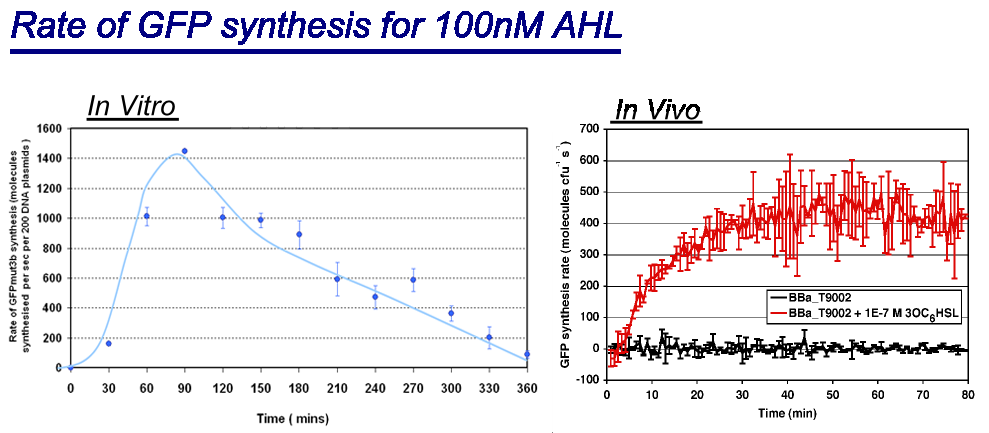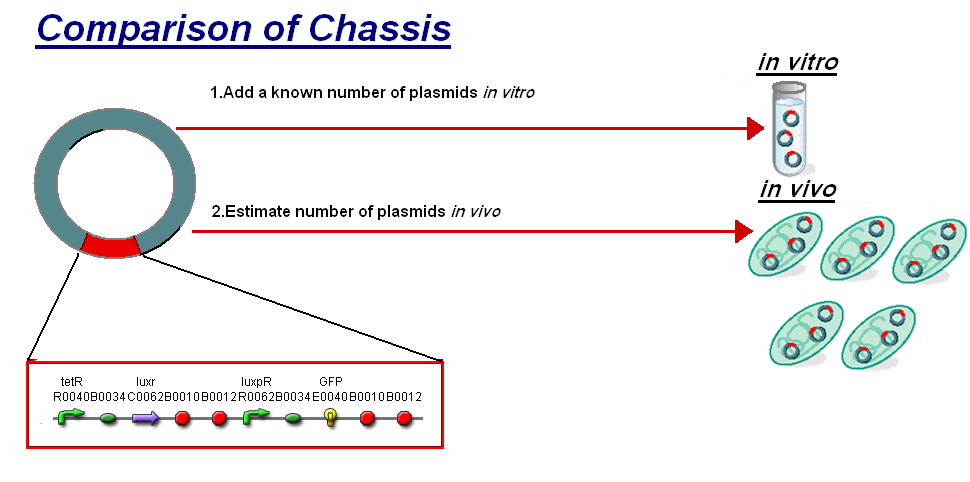Imperial/Infector Detector/F2620 Comparison
From 2007.igem.org
m (→Summary of Comparison) |
m (→Summary of Comparison) |
||
| Line 51: | Line 51: | ||
The graph shows the following: | The graph shows the following: | ||
*''in vivo'' has a '''maximal rate of 400-500 molecules of GFP synthesised per second per cell'''. In addition the rate reaches a steady state after around 30minutes and maintains it for the duration of the testing.<br> | *''in vivo'' has a '''maximal rate of 400-500 molecules of GFP synthesised per second per cell'''. In addition the rate reaches a steady state after around 30minutes and maintains it for the duration of the testing.<br> | ||
| - | *''in vitro'' has the equivalent of '''1400 molecules of GFP synthesised per second per cell equivalent''', the cell equilavent being based upon the normalization of DNA plasmids. Interestingly the ''in vitro'' chassis does not reach a steady state, in fact it decreases in rate of synthesis after 90 minutes and keeps decreasing until rate is zero at around 360 minutes. | + | *''in vitro'' has the equivalent of '''1400 molecules of GFP synthesised per second per cell equivalent''', the cell equilavent being based upon the normalization of DNA plasmids. Interestingly the ''in vitro'' chassis does not reach a steady state, in fact it decreases in rate of synthesis after 90 minutes and keeps decreasing until rate is zero at around 360 minutes. |
| - | < | + | |
| + | <span style="font-size:120%;">'''Key Difference:'''</span> | ||
| + | *Life of Synthesis - The life of synthesis of ''in vitro'' is about 90 minutes, this is compared to ''in vivo'' that can carry on synthesis for span of days. Both of the systems are finite, it is just a difference in the length of expression. ''In vitro'' is more of a burst of expression, giving a high but short rate of GFP synthesis. | ||
| + | |||
The reason why the ''in vitro'' chassis never reaches a steady state is because of the limited energy and metabolites available, this is unlike ''in vivo'' which is supported by the media that it is grown upon. | The reason why the ''in vitro'' chassis never reaches a steady state is because of the limited energy and metabolites available, this is unlike ''in vivo'' which is supported by the media that it is grown upon. | ||
<br> | <br> | ||
Revision as of 21:32, 26 October 2007

Summary of Comparison
We thought to compare our in vitro characterisation to the characterisation of [http://partsregistry.org/Part:BBa_F2620 F2620] in vivo with the aim to highlight some of the differences between the chassis and investigate how the constructs characteristics may change between them. The [http://partsregistry.org/Part:BBa_F2620 F2620] is an ideal construct to compare for comparison because of its detailed characterisation in vivo. The construct is the same as the construct 1 that was used for infecter detector, pTet-LuxR-pLux-GFPmut3b. The key results the comparison were;
- The creation of a new unit to allow comparison between in vitro and in vivo chassis.
- That although we are changing the E.coli chassis from in vivo to in vitro the construct characteristic response is independent of the chassis.
These are exciting findings, revealing the potential for the exploration of new chassis and the ability to use constructs in an exchangable mannor.
 |
| Comparison between in vivo and in vitro for rate of GFPmut3b synthesis for 100nM AHL. The in vivo chassis used was the bacterial strain MG1655 and the in vitro chassis was Promega Commercial S30 Cell Extract(60µl)
Key Difference:
The reason why the in vitro chassis never reaches a steady state is because of the limited energy and metabolites available, this is unlike in vivo which is supported by the media that it is grown upon.
|
Transfer Function
 |
| The graph above shows the transfer function of [AHL] input vs rate of GFP synthesis output. The graph shows the max rate of synthesis for each of the chassis; for in vivo this is the steady state reached after about 30 minutes and for in vitro it is the rate between 60 and 90 minutes which is the maximum rate before the energy limitations of the system cause the rate to drop. The blue line on corresponds to the range of AHL and the response of the in vitro chassis.
|
